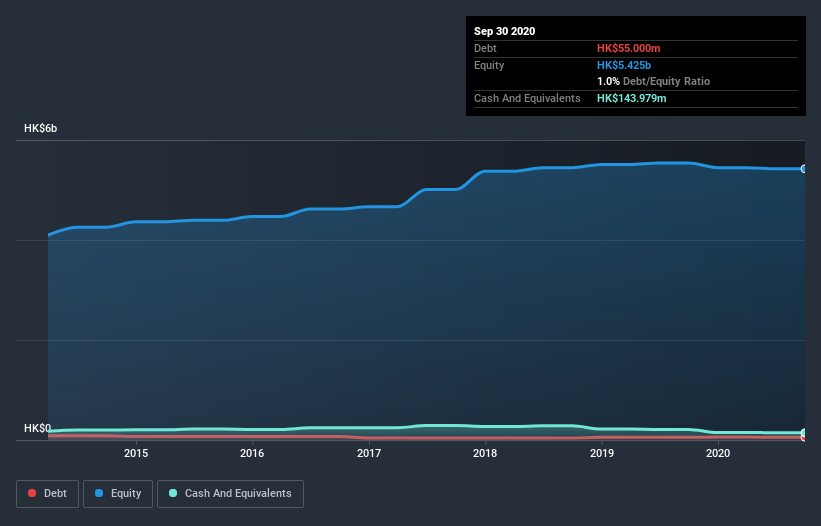The external fund manager backed by Berkshire Hathaway's Charlie Munger, Li Lu, makes no bones about it when he says 'The biggest investment risk is not the volatility of prices, but whether you will suffer a permanent loss of capital.' So it seems the smart money knows that debt - which is usually involved in bankruptcies - is a very important factor, when you assess how risky a company is. Importantly, Pokfulam Development Company Limited (HKG:225) does carry debt. But the more important question is: how much risk is that debt creating?
When Is Debt A Problem?
Debt is a tool to help businesses grow, but if a business is incapable of paying off its lenders, then it exists at their mercy. Ultimately, if the company can't fulfill its legal obligations to repay debt, shareholders could walk away with nothing. However, a more common (but still painful) scenario is that it has to raise new equity capital at a low price, thus permanently diluting shareholders. Of course, plenty of companies use debt to fund growth, without any negative consequences. The first thing to do when considering how much debt a business uses is to look at its cash and debt together.
View our latest analysis for Pokfulam Development
What Is Pokfulam Development's Net Debt?
The chart below, which you can click on for greater detail, shows that Pokfulam Development had HK$55.0m in debt in September 2020; about the same as the year before. However, it does have HK$144.0m in cash offsetting this, leading to net cash of HK$89.0m.

How Strong Is Pokfulam Development's Balance Sheet?
We can see from the most recent balance sheet that Pokfulam Development had liabilities of HK$126.7m falling due within a year, and liabilities of HK$47.3m due beyond that. Offsetting these obligations, it had cash of HK$144.0m as well as receivables valued at HK$11.8m due within 12 months. So its liabilities outweigh the sum of its cash and (near-term) receivables by HK$18.2m.
Having regard to Pokfulam Development's size, it seems that its liquid assets are well balanced with its total liabilities. So while it's hard to imagine that the HK$1.27b company is struggling for cash, we still think it's worth monitoring its balance sheet. Despite its noteworthy liabilities, Pokfulam Development boasts net cash, so it's fair to say it does not have a heavy debt load!
On the other hand, Pokfulam Development saw its EBIT drop by 7.6% in the last twelve months. If earnings continue to decline at that rate the company may have increasing difficulty managing its debt load. The balance sheet is clearly the area to focus on when you are analysing debt. But you can't view debt in total isolation; since Pokfulam Development will need earnings to service that debt. So if you're keen to discover more about its earnings, it might be worth checking out this graph of its long term earnings trend.
Finally, a company can only pay off debt with cold hard cash, not accounting profits. Pokfulam Development may have net cash on the balance sheet, but it is still interesting to look at how well the business converts its earnings before interest and tax (EBIT) to free cash flow, because that will influence both its need for, and its capacity to manage debt. During the last three years, Pokfulam Development produced sturdy free cash flow equating to 71% of its EBIT, about what we'd expect. This free cash flow puts the company in a good position to pay down debt, when appropriate.
Summing up
We could understand if investors are concerned about Pokfulam Development's liabilities, but we can be reassured by the fact it has has net cash of HK$89.0m. And it impressed us with free cash flow of HK$60m, being 71% of its EBIT. So is Pokfulam Development's debt a risk? It doesn't seem so to us. There's no doubt that we learn most about debt from the balance sheet. But ultimately, every company can contain risks that exist outside of the balance sheet. To that end, you should learn about the 2 warning signs we've spotted with Pokfulam Development (including 1 which is a bit unpleasant) .
At the end of the day, it's often better to focus on companies that are free from net debt. You can access our special list of such companies (all with a track record of profit growth). It's free.
If you decide to trade Pokfulam Development, use the lowest-cost* platform that is rated #1 Overall by Barron’s, Interactive Brokers. Trade stocks, options, futures, forex, bonds and funds on 135 markets, all from a single integrated account. Promoted
New: Manage All Your Stock Portfolios in One Place
We've created the ultimate portfolio companion for stock investors, and it's free.
• Connect an unlimited number of Portfolios and see your total in one currency
• Be alerted to new Warning Signs or Risks via email or mobile
• Track the Fair Value of your stocks
This article by Simply Wall St is general in nature. It does not constitute a recommendation to buy or sell any stock, and does not take account of your objectives, or your financial situation. We aim to bring you long-term focused analysis driven by fundamental data. Note that our analysis may not factor in the latest price-sensitive company announcements or qualitative material. Simply Wall St has no position in any stocks mentioned.
*Interactive Brokers Rated Lowest Cost Broker by StockBrokers.com Annual Online Review 2020
Have feedback on this article? Concerned about the content? Get in touch with us directly. Alternatively, email editorial-team (at) simplywallst.com.
About SEHK:225
Pokfulam Development
An investment holding company, invests in, develops, and manages real estate properties in Hong Kong.
Average dividend payer with mediocre balance sheet.
Similar Companies
Market Insights
Community Narratives



